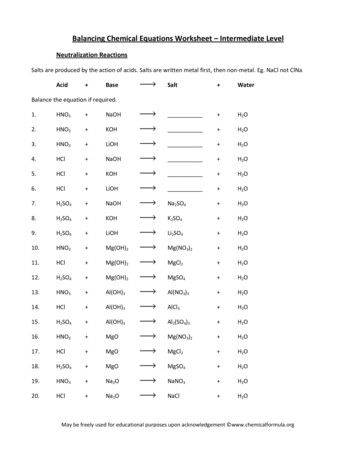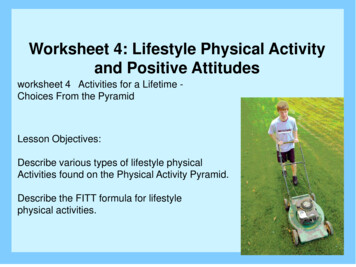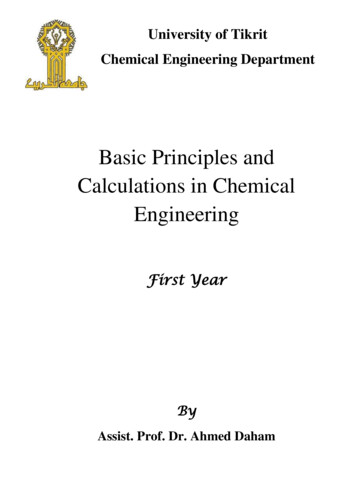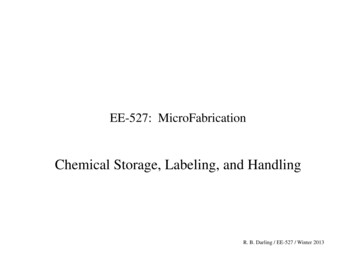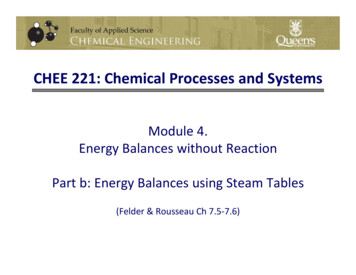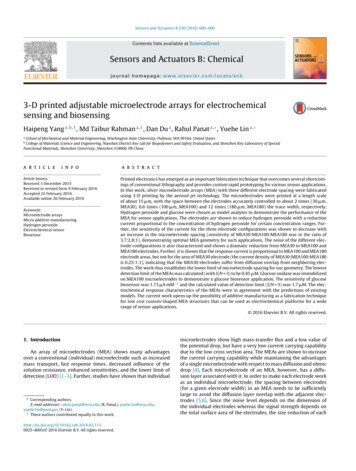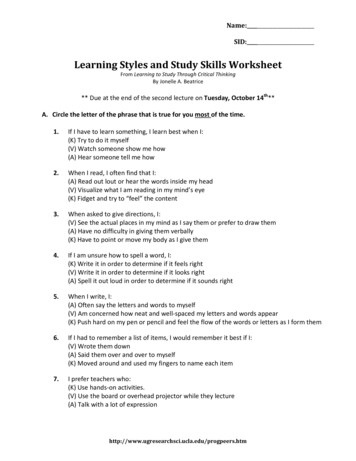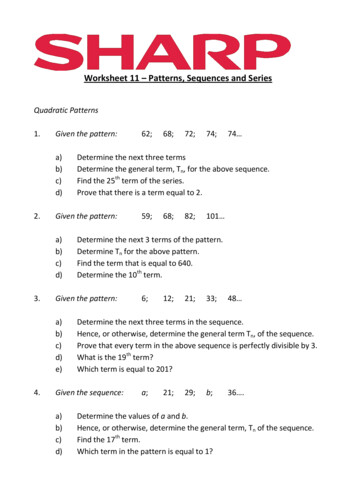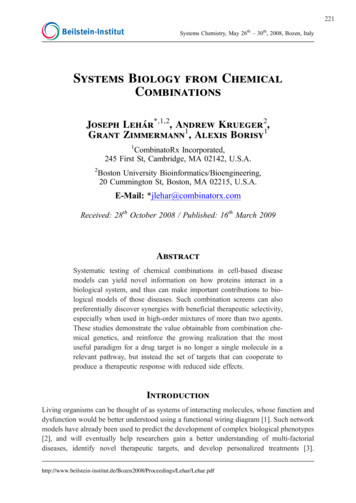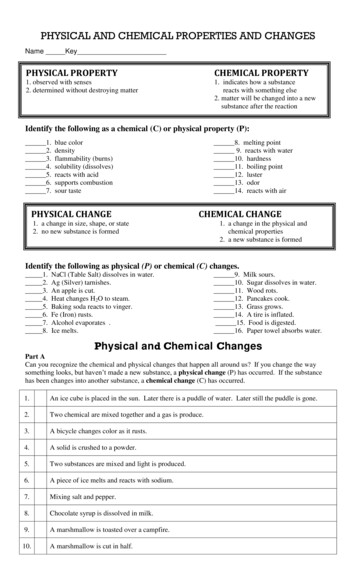
Transcription
PHYSICAL AND CHEMICAL PROPERTIES AND CHANGESName KeyPHYSICAL PROPERTYCHEMICAL PROPERTY1. observed with senses2. determined without destroying matter1. indicates how a substancereacts with something else2. matter will be changed into a newsubstance after the reactionIdentify the following as a chemical (C) or physical property (P):1.2.3.4.5.6.7.blue colordensityflammability (burns)solubility (dissolves)reacts with acidsupports combustionsour tastePHYSICAL CHANGE8. melting point9. reacts with water10. hardness11. boiling point12. luster13. odor14. reacts with airCHEMICAL CHANGE1. a change in size, shape, or state2. no new substance is formed1. a change in the physical andchemical properties2. a new substance is formedIdentify the following as physical (P) or chemical (C) changes.1.2.3.4.5.6.7.8.NaCl (Table Salt) dissolves in water.Ag (Silver) tarnishes.An apple is cut.Heat changes H2O to steam.Baking soda reacts to vinger.Fe (Iron) rusts.Alcohol evaporates .Ice melts.9. Milk sours.10. Sugar dissolves in water.11. Wood rots.12. Pancakes cook.13. Grass grows.14. A tire is inflated.15. Food is digested.16. Paper towel absorbs water.Physical and Chem ical ChangesPart ACan you recognize the chemical and physical changes that happen all around us? If you change the waysomething looks, but haven’t made a new substance, a physical change (P) has occurred. If the substancehas been changes into another substance, a chemical change (C) has occurred.1.An ice cube is placed in the sun. Later there is a puddle of water. Later still the puddle is gone.2.Two chemical are mixed together and a gas is produce.3.A bicycle changes color as it rusts.4.A solid is crushed to a powder.5.Two substances are mixed and light is produced.6.A piece of ice melts and reacts with sodium.7.Mixing salt and pepper.8.Chocolate syrup is dissolved in milk.9.A marshmallow is toasted over a campfire.10.A marshmallow is cut in half.
Part BRead each scenario. Decide whether a physical or chemical change has occurred and give evidence for yourdecision. The first one has been done for you to use as an example.Scenario1.Umm! A student removes a loaf of breadhot from the oven. The student cuts a sliceoff the loaf and spreads butter on it.2.Your friend decides to toast a piece ofbread, but leaves it in the toaster too long.The bread is black and the kitchen if full ofsmoke.3.You forgot to dry the bread knife when youwashed it and reddish brown spotsappeared on it.4.You blow dry your wet hair.5.In baking biscuits and other quick breads,the baking powder reacts to release carbondioxide bubbles. The carbon dioxidebubbles cause the dough to rise.6.You take out your best silver spoons andnotice that they are very dull and havesome black spots.7.A straight piece of wire is coiled to form aspring.8.Food color is dropped into water to give itcolor.9.Chewing food to break it down into smallerparticles represents a change,but the changing of starch into sugars byenzymes in the digestive system representsa change.10.In a fireworks show, the fireworks explodegiving off heat and light.Physical orChemicalChange?Part C: True (T) or False (F)1.Changing the size and shapes of pieces of wood would be a chemical change.2.In a physical change, the makeup of matter is changed.3.Evaporation occurs when liquid water changes into a gas.4.Evaporation is a physical change.5.Burning wood is a physical change.6.Combining hydrogen and oxygen to make water is a physical change.7.Breaking up concrete is a physical change.8.Sand being washed out to sea from the beach is a chemical change.9.When ice cream melts, a chemical change occurs.10.Acid rain damaging a marble statue is a physical change.Evidence
PHYSICAL AND CHEMICAL PROPERTIES AND CHANGESName KeyPHYSICAL PROPERTYCHEMICAL PROPERTY1. observed with senses2. determined without destroying matter1. indicates how a substancereacts with something else2. matter will be changed into a newsubstance after the reactionIdentify the following as a chemical (C) or physical property (P):P 1. blue colorP 2. densityC 3. flammability (burns)P 4. solubility (dissolves)C 5. reacts with acidC 6. supports combustionP) 7. sour tastePHYSICAL CHANGEP 8. melting pointC 9. reacts with waterP 10. hardnessP 11. boiling pointP 12. lusterP 13. odorC 14. reacts with airCHEMICAL CHANGE1. a change in size, shape, or state2. no new substance is formed1. a change in the physical andchemical properties2. a new substance is formedIdentify the following as physical (P) or chemical (C) changes.P 1.C 2.P 3.P 4.C 5.C 6.P 7.P 8.NaCl (Table Salt) dissolves in water.Ag (Silver) tarnishes.An apple is cut.Heat changes H2O to steam.Baking soda reacts to vinger.Fe (Iron) rusts.Alcohol evaporates.Ice melts.C 9. Milk sours.P 10. Sugar dissolves in water.C 11. Wood rots.C 12. Pancakes cook.C 13. Grass grows.P 14. A tire is inflated.C 15. Food is digested.P 16. Paper towel absorbs water.Physical and Chem ical ChangesPart ACan you recognize the chemical and physical changes that happen all around us? If you change the waysomething looks, but haven’t made a new substance, a physical change (P) has occurred. If the substancehas been changes into another substance, a chemical change (C) has occurred.1.PAn ice cube is placed in the sun. Later there is a puddle of water. Later still the puddle is gone.2.CTwo chemical are mixed together and a gas is produce.3.CA bicycle changes color as it rusts.4.PA solid is crushed to a powder.5.CTwo substances are mixed and light is produced.6.PC A piece of ice melts and reacts with sodium.7.PMixing salt and pepper.8.PChocolate syrup is dissolved in milk.9.CA marshmallow is toasted over a campfire.10. PA marshmallow is cut in half.
Part BRead each scenario. Decide whether a physical or chemical change has occurred and give evidence for yourdecision. The first one has been done for you to use as an example.ScenarioPhysical orChemicalChange?1.Umm! A student removes a loaf of breadhot from the oven. The student cuts a sliceoff the loaf and spreads butter on it.Physical2.Your friend decides to toast a piece ofbread, but leaves it in the toaster too long.The bread is black and the kitchen if full ofsmoke.Chemical3.You forgot to dry the bread knife when youwashed it and reddish brown spotsappeared on it.Chemical4.You blow dry your wet hair.Physical5.In baking biscuits and other quick breads,the baking powder reacts to release carbondioxide bubbles. The carbon dioxidebubbles cause the dough to rise.Chemical6.You take out your best silver spoons andnotice that they are very dull and havesome black spots.Chemical7.A straight piece of wire is coiled to form aspring.PhysicalNo change in substances.No unexpected color change, temperaturechange or gas given off.8.Food color is dropped into water to give itcolor.PhysicalNo change in substances.No unexpected color change, temperaturechange or gas given off.9.Chewing food to break it down into smallerparticles represents a change,but the changing of starch into sugars byenzymes in the digestive system representsa change.Physical thenChemicalChewing breaks down matter into smallerparticles of the same substance.Enzymes change starch into sugar which isa new substance.10.In a fireworks show, the fireworks explodegiving off heat and light.ChemicalIdentity of substances change. Fireworkscombust making new products and energy.Evidence No change in substances.No unexpected color change, temperaturechange or gas given off.Identity of substances change.Blackening of bread and smoke is the newsubstanceIdentity of substances change.Iron of knife forms rustNo change in substances.No unexpected color change, temperaturechange or gas given off.Identity of substances change.Gas is producedIdentity of substances change.Silver oxide producedPart C: True (T) or False (F)1.FChanging the size and shapes of pieces of wood would be a chemical change.2.FIn a physical change, the makeup of matter is changed.3.TEvaporation occurs when liquid water changes into a gas.4.TEvaporation is a physical change.5.FBurning wood is a physical change.6.FCombining hydrogen and oxygen to make water is a physical change.7.TBreaking up concrete is a physical change.8.FSand being washed out to sea from the beach is a chemical change.9.FWhen ice cream melts, a chemical change occurs.10.FAcid rain damaging a marble statue is a physical change.
5. Burning wood is a physical change. 6. Combining hydrogen and oxygen to make water is a physical change. 7. Breaking up concrete is a physical change. 8. Sand being washed out to sea from the beach is a chemical change. 9. When ice cream melts, a chemical change occurs. 10. Acid rain damagi
